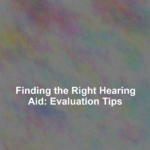Navigating the world of hearing aids can be akin to finding your way through a labyrinth; with so many twists and turns, itG??s easy to feel lost. You want a device that not only restores your hearing but also fits seamlessly into your lifestyle.
To start, youG??ll need to pinpoint your specific hearing requirements and preferences. From in-the-canal models to over-the-ear pieces, each type offers distinct advantages. But itG??s not just about style; features such as noise reduction, connectivity, and battery life play crucial roles in your day-to-day satisfaction.
While considering cost, remember that value extends beyond the price tagG??warranty, service, and durability are equally important. YouG??re on the brink of making a decision that will significantly impact your quality of life, and itG??s essential to weigh these factors carefully.
Stay tuned, as youG??re about to uncover the key considerations that will guide you to the hearing aid that best resonates with your personal needs.
Assessing Your Hearing Needs
Before exploring the myriad of hearing aid options available, itG??s essential to assess your specific hearing needs to ensure you find the most suitable device. Your journey to better hearing starts with understanding the nature and extent of your hearing loss. YouG??ll need a comprehensive hearing test, usually conducted by an audiologist or a licensed hearing specialist, to pinpoint the frequencies and situations where youG??re having difficulty.
Once youG??ve got your test results, itG??s time to think about your lifestyle. Are you active, needing something robust and water-resistant? Or maybe you spend a lot of time in noisy environments and could benefit from advanced noise reduction features. DonG??t forget to consider your dexterity; if handling tiny batteries seems frustrating, rechargeable hearing aids could be your best bet.
ItG??s also important to be realistic about your budget. While you shouldnG??t skimp on a device that could vastly improve your quality of life, youG??ll want to find a balance between cost and features. Some health insurance plans cover part or all of the cost of hearing aids, so check your benefits before making a decision.
Understanding Hearing Aid Types
Having assessed your hearing needs, youG??ll now want to explore the different types of hearing aids to find the one that fits your lifestyle and preferences. ItG??s crucial to understand the main categories available to you.
Behind-The-Ear (BTE) models are some of the most common. They house the electronics in a casing that rests behind your ear, with a tube that directs sound into your ear canal. TheyG??re known for durability and power, making them suitable for a wide range of hearing loss.
In-The-Ear (ITE) hearing aids are custom-molded and fit entirely inside your outer ear. TheyG??re less visible than BTE aids but can be easier to handle if you have dexterity issues.
Completely-In-Canal (CIC) and Invisible-In-Canal (IIC) options are even more discreet. These are molded to fit deep inside your ear canal, making them nearly invisible. However, their small size means they may not have as much power or battery life as larger models.
Finally, Receiver-In-Canal (RIC) hearing aids are similar to BTEs but have the speaker built into the ear tip, which can provide a more natural sound quality.
Each type comes with its own set of pros and cons. Consider your prioritiesG??whether itG??s invisibility, ease of use, or powerG??when making your choice.
Analyzing Feature Sets
When youG??re comparing hearing aids, delve into the feature sets to determine which functionalities align with your daily needs and hearing goals. DonG??t get dazzled by all the bells and whistles; instead, focus on whatG??ll enhance your hearing experience.
For instance, if youG??re active and outdoorsy, you might want a hearing aid with durable construction and moisture resistance. Are you tech-savvy and always on your smartphone? Look for models that offer seamless connectivity to your devices. And if you find yourself frequently in noisy environments, sophisticated noise reduction features could be a game changer for you.
Remember:
- Battery Life: Check how long the batteries last and consider rechargeable options if you donG??t want the hassle of frequent changes.
- Directional Microphones: These can improve your ability to hear conversations in noisy places by focusing on the sound coming from in front of you.
- Feedback Suppression: This helps to minimize annoying whistling sounds that can occur with hearing aid use.
Ultimately, the right hearing aid should integrate smoothly into your life. So, take your time, analyze the features carefully, and choose the one that will make your world sound just right.
Comparing Pricing and Value
After carefully considering the features that best suit your lifestyle, itG??s equally important to weigh the cost and overall value of your hearing aid options. Prices for hearing aids can vary widely, from a few hundred to several thousand dollars per ear. DonG??t let sticker shock deter you; remember, a higher price doesnG??t always guarantee superior quality or better results for you.
Assess the pricing in the context of the aidG??s lifespan. A pricier model might last longer and have a better warranty, potentially saving money over time. Look for value-added services like free trials, fitting adjustments, and follow-up care which can make a higher upfront cost more palatable.
Also, consider the manufacturerG??s reputation and customer service. Good customer support can be invaluable if you need help troubleshooting or repairing your device. Sometimes, the peace of mind that comes with reliable service is worth the extra expense.
Lastly, explore financing options, insurance coverage, and possible assistance from charitable organizations if cost is a major concern. Investing in the right hearing aid means investing in your quality of life, so balance your budget with your need for a device that will perform well in the situations you encounter most.
Checking Reviews and Reputation
Researching customer reviews and company reputations can give you valuable insight into the real-world performance and reliability of different hearing aids. ItG??s a step you shouldnG??t skip. When youG??re diving into reviews, youG??ll find a wealth of experiences that can highlight the strengths and weaknesses of the models youG??re considering. But donG??t just skim the surface; look for recurrent themes in the feedback to gauge consistency.
As you sift through reviews, keep an eye out for comments on:
- Sound Quality: Are users consistently praising clarity or complaining about distortion?
- Comfort: Is there a trend of people mentioning discomfort or praising the fit?
- Customer Service: How do users describe their interactions with the company when they needed support?
Conclusion
YouG??ve looked at your hearing needs, understood the different types, and analyzed the features.
Now, consider the cost and value, ensuring it aligns with your budget and requirements. DonG??t forget to check reviews and the reputation of brands and providers.
By doing so, youG??ll find the best hearing aid for you. Remember, investing in the right device will significantly improve your quality of life, so choose wisely and enjoy the world of sound that awaits you.









